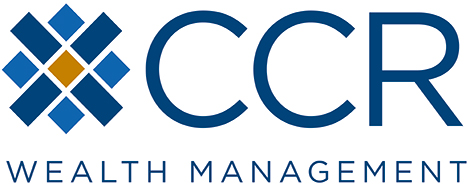April 2023 Market Outlook
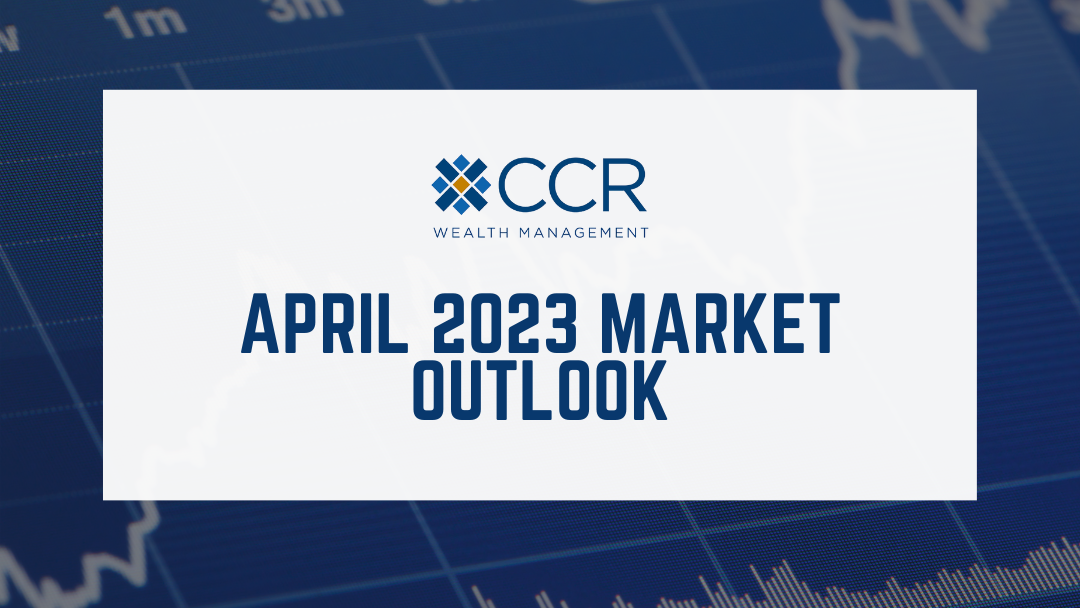
"Diversity and independence are important because the best collective decisions are the product of disagreement and contest, not consensus or compromise."
-James Suroweicki
The Wisdom of Crowds
Spring tidings from CCR Wealth Management!
Aware that our readership of this publication has grown in the last few months, we extend a hearty welcome to clients who have joined us through financial advisors that have recently combined with our team! Our quarterly Outlook is designed to provoke thought and spark conversation. While so much investment commentary is given to making predictions or mulling over the recent past in minute detail, predictions and recaps are a thumbs' swipe away for anyone with access to the internet-to your heart's content. We prefer to communicate our perspective on some of the more prevalent events and narratives of the day instead. To the extent we have expectations (and we do)-we know that our feet cannot be planted in cement.
This is especially true in today's market environment. We regularly survey the landscape of managers,, including the opinions of portfolio managers we have engaged (and those we have not), financial journals, macro-economic research to which we subscribe, and more. Our own nearly 30 years of capital markets experience lends its own perspective as well. One thing that has struck us as the year has progressed is the significant inconsistency of expectations across these channels-both in terms of economic expectations and probable market outcomes. Moreover, most of these opinions are held with very low conviction. More consistent cases, the business model over the years has been our criticism and critique of financial journalism-in all its forms. Not because it is "wrong" or "inaccurate", but because its ubiquity makes it the most likely source of input for most individual investors' perceptions and expectations. As such it is given more credibility as "guidance" than is warranted (in most is 100% ad sales, with little stake in the success of your investment outcomes).
In January we cited several Wall Street Journal articles declaring, "The 60/40 Investment Strategy is Dead". They were referring of course to a very common principle of allocation between stocks and bonds. Recall that we were very critical of this declaration-common among journalists and Wall Street product manufacturers at the time. Our criticism was largely focused on our expectation that the worst of the bond market was likely behind us, and that the outlook for this asset class (generally) seemed quite attractive. More recently (April 13th), the Journal's latest headline on the subject was, "The 60-40 Investment Strategy is Back…". A very temporary death, indeed. One of the more reliable axioms for individual investors should be the unreliability of financial journalism in guiding investment strategy, whether it prompts you to swap your long-term strategy for CDs or prompted you in the past to believe that crypto was the indisputable waves of the future.
This Outlook edition is chock-full of charts. As they say, a picture is worth a thousand words. We will be telling a story, of sorts. It is our own "narrative" if you will. But we write it in pencil.
Today is tax-day. The S&P 500, a broad measure of the US stock market, is up 8.31%.
Let's back up a couple weeks to March 31, when the S&P 500 closed out the first quarter up 7.50%. Subtract Information Technology's 21.82% return from the index and the S&P 500 was up only 2.71%. Subtract stocks, no longer grouped within the Technology GICS, and the broad index return is actually negative. Investors (and particularly Indexers) should always remember that this and other broadly cited market barometers are usually market-cap weighted, and that five out of eight of the largest market caps in the S&P 500 are tech giants. In fact, of the 11 GICS sectors represented in the index, technology holds a 26% weighting. The next largest weighting is in healthcare, at 14% (down 1.6% through April 6th). So, to a large extent-as tech goes, so goes the market.
To be fair to tech, we have thus far used the sector as a proxy for the "growth" stock category. Without re-hashing the reasons why, recall that "growth stocks" were the hardest hit of the 2022 bear market. The Nasdaq 100 index*, a reasonable proxy for large-cap growth, was down almost 33% last year, relative to the S&P 500's dismal 18% drop.
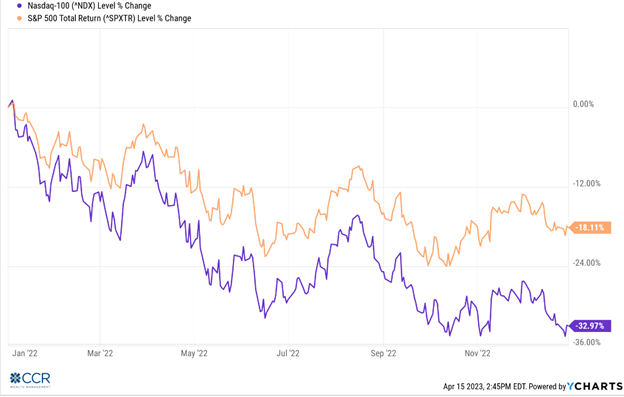
As all investors have learned, interest rates (and future rate expectations) tend to have an outsized impact on higher growth companies. Higher cashflow growth assumptions into the future, discounted at higher interest rates back to today make higher valuations especially vulnerable. Of the biggest questions begging an answer about the near-term future of US equity markets is, "whither growth?" This is important because of its market cap weighting in our growth-oriented economy and broadest market indicators. And the answer to this question is, in-turn, reliant on the answer to "whither interest rates?". The chart above rehashes last year, and we understand if you would rather forget.
The chart below, however, might help in bringing expectations in-line with our own, and in imagining a near-term where growth stock valuations may be a bit ahead of themselves (again) on a year-to-date basis.
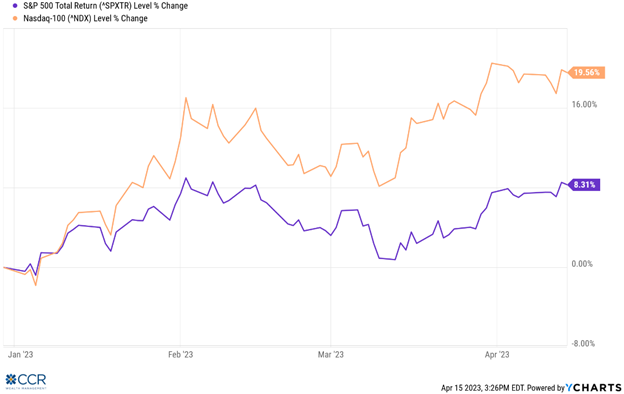
The Philadelphia Semiconductor Index is up over 21% year-to-date. The Dow Jones Software index** is up almost 19% year-to-date as we write (with little in the way of peers in the "Communications Services" index). We could be wrong, in fact, we are always prepared to be wrong, but right now, we don't believe our lyin' eyes.
Why?
Because the equity markets, and especially these components of the equity markets, are acting as if the US is coming out of a recession. Most of the data we have surveyed point to the fact that the US is (at best) approaching an economic stall-speed, and (likely) going into a recession. Now we can debate how debilitating this recession might be. We see no evidence of significant economic bubbles, though from where we sit, certain areas of the market may be reflating a little quickly. But there is a paradox here that has us-and others--scratching our heads.
We will take it one step further. As there has been ample evidence of a slowing economy in various economic and market indices (more on this later), one would expect defensive areas of the market to have relative outperformance over cyclical, more economically sensitive sectors, and especially higher valuation equities. This comports with both logic and vast swaths of history. Defensive sectors usually include Healthcare, Utilities and Consumer Staples.
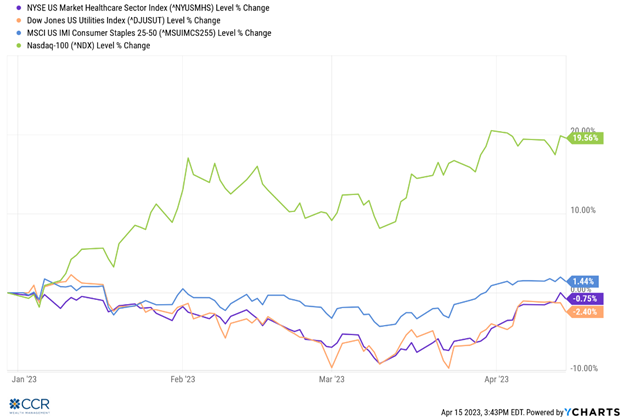
But this is not what we have been seeing so far this year. Year-to-date returns in more defensive areas of the market have been anemic, or negative. Checking in with net equity fund-flows (this is a measure of all funds flowing into all equity mutual funds and ETFs, minus funds flowing out), and we see funds flows are negative by about $21 billion so far this year. Net fund flows are a decent, if imperfect measure of the supply and demand that generally fuels equity markets. (Note: the nearby Fund Flow chart only goes through February, but we will surmise the collapse of SVB and Signature Bank did not inspire an influx of cash into equities in March).
So, the rise in growth stocks is not coming from cash on the sidelines. Rather, it seems to be a result of "sector rotation", whereby investors have been selling exposures in Energy, Healthcare, Utilities and other defensive areas which did relatively well last year and moving those funds to growth--last year's losers. The wisdom of this remains to be seen-but we think an examination of last summer's rally in growth-and its ultimate demise--is worth the effort.
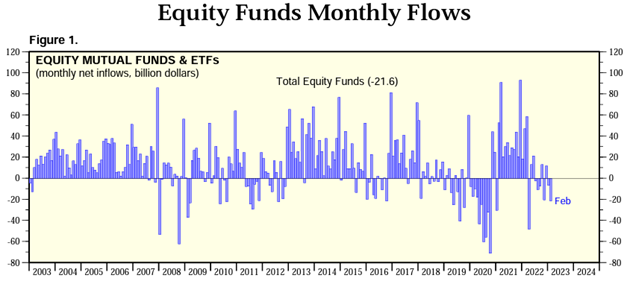
Witness last summer's rally in growth-oriented stocks from mid-June to mid-August relative to the Russell 1000 Value index (a broad index heavy in defensive sectors). Then witness the ensuing two months of reversal:
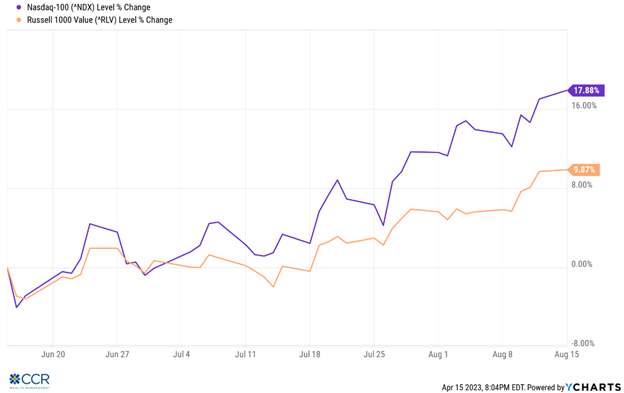
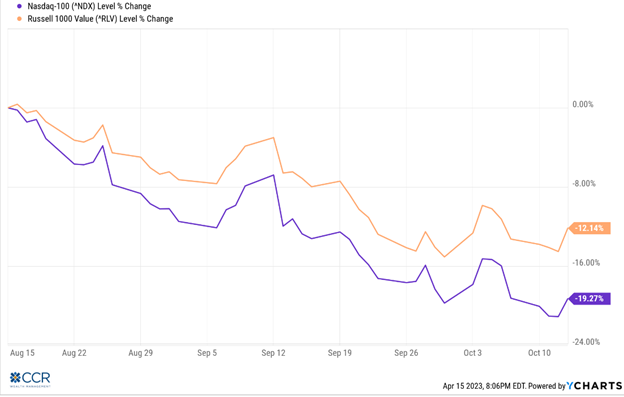
A big outperformance of growth (vs. value) in June-August was almost entirely erased from August into October. Our narrative sees similarities between year-to-date market moves and those of last summer. And to illustrate this, we will pivot the conversation to interest rates, the Fed, and market expectations.
Much has been said of the "wisdom of crowds". In many ways, the equity markets are seen as a reasonable leading economic indicator. This reputation has been earned over many decades as the embodiment of the collective expectation for future earnings. But as previously hinted at in our discussion of GICS within the market, the S&P 500 (and other broad market indexes) are in fact markets of markets. In the near-term, crowds are not remotely infallible. And markets often operate outside of "logic". Think upon the numerous manias that have gripped (and ripped) investors over the ages, from the Tulip Mania and South Sea Stock bubble of the 17th and 18th centuries, to the dot-com and real-estate manias of our own era, and many, many lesser anomalies in between. Our point is not to raise all past market mis-pricings to the level of a mania, but to show that the market's status of leading indicator generally only works 1) in hindsight, and 2) over much longer periods of time.
The futures markets are a place where investors of all stripes get to express their views on the near-term direction of many things (investments and politics among them). Futures contracts are traded on the direction and level of the Fed Funds rate, the rate managed by the Fed that accounts for most of what we consider to be monetary policy. Below, we illustrate the Fed Funds rate through June of last summer, with the dotted lines on the right-hand side being expectations-either of the collective Federal Reserve Board of Governors (blue dotted line), or the Market, based on futures contract pricing (green dotted line). The solid grey line is simply historical fact up to June 30 (2022).
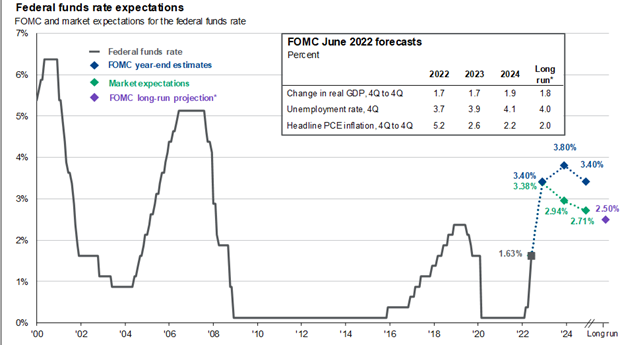

To summarize, nearly a year ago the wisdom of crowds expected the effective Fed Funds rate to top-out at 3.38% by December, and after a series of rate cuts, to be closer to 2.94% by today. Rate cuts? Let's party! Based on this wisdom, scroll up and look again at what the Nasdaq 100 did last summer. Party, indeed. But, the effective Fed Funds rate ended up at 4.10% last December, and today stands at 4.88%. The inflation data that (painfully) drove the market back into sobriety resulted in the swooning retracement of the late summer.
Now, let us look at a current picture of the Fed Funds rate, along with market expectations:
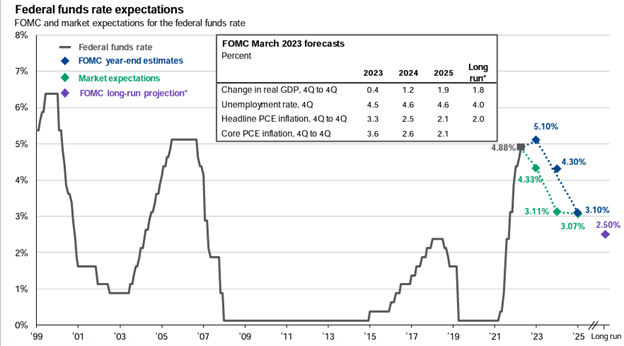

It appears that not only is the market unconvinced of any future rate hikes, but at least 0.50% of rate cuts are expected before the end of the year. A year from now-wow-Fed Funds is down to 3%! Que-up the party music again, and perhaps this explains the significant disparity between the "tech and growth" crowds, and the more defensive areas of the market thus far this year. Smash them together-and you get the S&P 500 up 8.31% in mid-April.
We can't say enough that we could be wrong-and we will adjust our assumptions given the data that shows it. But this scenario is a significant departure from our base-case. In January we cited Jerome Powel's comments from last August that "some pain" is on the horizon. Were the SVB and Signature Bank failures, higher mortgage and credit card rates the total sum of this pain? In our view, this seems to be what the green dotted line (the wisdom of crowds) is telling us.
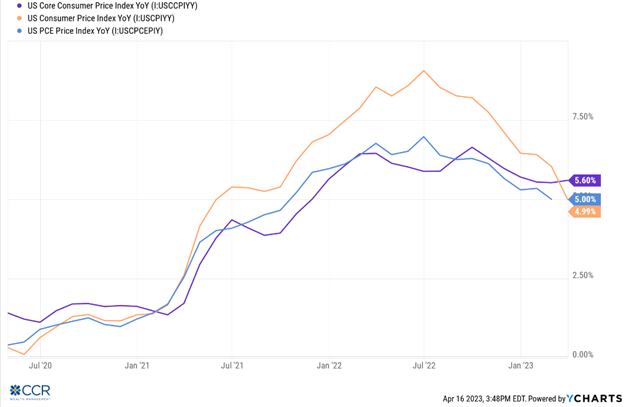
Interest rates, rate expectations and the like should naturally lead to a discussion of the notion of inflation itself, the driving force behind all of last year's gyrations. A couple reminders before we let one more chart give us a history lesson. Headline Inflation (CPI) is aptly named, as it is what many in the media talk about. This rate measured on a year-over-year basis peaked at 9.1% last June (reported last July). Through last March, this measure has dropped to 5.00%. On its face, this is obviously good news. The problem is, the Fed doesn't pay nearly as much attention to this measure as the media does, and rightly so. CPI can be unduly affected by things like the war in Ukraine, tensions in the Middle East, or a drought in the Midwest (nothing the Fed can do about any of these things). But even Core CPI (ex-food and energy) has shown how stubborn inflation can be. Core CPI for February rose month over month (while CPI dropped) from 5.50% to 5.60%--largely attributed to shelter inflation, which is an item we discussed back in January as likely remaining murky due to the year-over-year nature in both appraisals and rental renewals. And while Core inflation has dropped yoy, it has not dropped nearly as much as has CPI.
As of this writing, we still do not have the PCE (or Core PCE data), but let us dive into a bit of history:
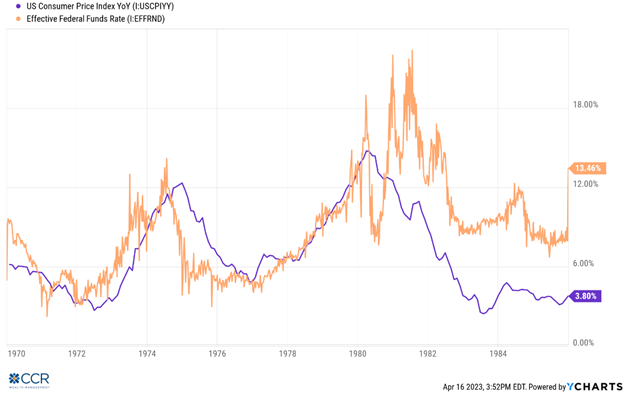
Ronald Reagan is quoted as saying, "Inflation is as violent as a mugger, as frightening as an armed robber and as deadly as a hit man". Choose your own pithy quote about inflation-there are many to choose from. Basically, all of them impart the importance of taming this beast. Behold the 1970's in the nearby chart.
Strictly speaking, there were two official recessions in the 1970s (1974-1975 and 1979-1982). Taken together, it was largely a decade of fantastic music, but economic misery. There are important differences before we become too ensconced in history: OPEC does not have the same stranglehold on world energy as it did 45-50 years ago, and the technological advancements made over this period have been disinflationary and have transformed our society, and our economy (we should also add that there have been several adjustments to the make-up of CPI since then). However, Jerome Powel is 70 years old, and we think he understands the history, and the stakes.
Notice how the Fed raised interest rates sharply in the early seventies in response to sharply rising prices. Recession #1. But rates were cut just as quickly-even before pricing pressures started to ease, likely due to the recession higher rates contributed to. The net result was a resurgence in inflation to even higher levels in the latter part of the decade. A new Fed Chairman then went to war against inflation, not only raising the rate above CPI , but keeping rates well above CPI for an elongated period. Recession #2. To-date, this is the reigning model of success in how to beat inflation.
Our skepticism that Jerome Powell and the FOMC are salivating about their first interest rate cut has more than one source, but the current lack of much real "pain" in this economy (to-date), along with the historical context just described certainly contributes to it. If we are more right than wrong (all we can generally hope for in our role), then growth stocks are overvalued again, defensive markets are under appreciated, and we continue with the "saw-tooth pattern" in the broader markets that we have described in the previous two Outlooks.
The PAIN:
We spilled some ink in January discussing the lag-effect of interest rate hikes, and the incremental impact on various financial versus economic measures. We have just begun the Q1 earnings season, and our supposition has been that we will now begin to see the effects of the higher cost of capital in the economy, and in earnings. Fairly deep into this Outlook, and we have yet to parse the most recent "media event" of the collapse of two regional banks (and the stress on the sector as a whole). We use the term "media event" because their best interest is served by turning every market pothole into a full-blown "crisis". An internal note to CCR advisors expressed our view that this was no more a crisis than marijuana stocks were a future wave of prosperity. Most banks are well capitalized, most banks are well managed, and while there may be some additional exceptions to this rule, a wave of banking failures in this country is a very low probability. "Recency bias" is a behavioral finance topic. We all remember the financial crisis of 14 years ago. While we don't dismiss the conundrum banks find themselves in, we are nowhere near that danger. We are, on the other hand, gob-smacked at the incompetence of the San Francisco branch of the Federal Reserve (oversight)-but that's a different topic.
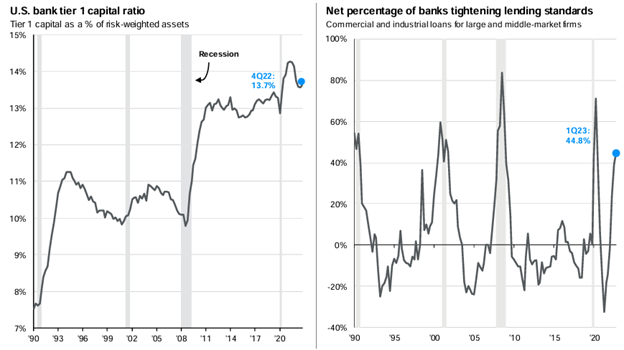

The issues that impact the near-term flexibility of other regional banks are purely a symptom of the higher cost of capital, not an existential crisis for the sector, no matter what CNBC says. This quarter and next will provide us with a clearer picture, but we believe Powel's Pain will finally begin to be felt.
Recently a staff presentation within the Fed predicted that last month's banking episode would likely tilt the economy into a recession. We find that partly accurate. Tighter lending standards going forward are guaranteed-but that's a credit decision. Couple that with the higher costs of capital, and the as-yet unknown effects of raising interest rates by nearly 5% in a year, and we think the coming recession will have many mothers.
Commercial real estate has often been mentioned as the next shoe-to-drop (after the regional banks). And while we don't disagree, generally, we think that brush is too broad. Last year the publicly traded REIT market was the worst performing sector in the bear market. Here, we think the leading indicator status of stocks might be onto something, but investors need to be discerning. High-vacancy office buildings…bad (remember how awesome the post-Covid "work-from-home" revolution was going to be?). Multi-family apartment buildings-not so bad. Stocks trade, rightly or wrongly, on the immediacy of new information. Non-publicly traded commercial real estate, while still subject to the same influences of interest rates (higher cap-rates in the valuations), get appraised only once a year. Those lower adjusted valuations will become apparent over several of the coming months.
The Pain, in our view, will ultimately depend on the strength of balance sheets as well as the nature of the debt, no matter the industry. And here, we will make our last pivot-to the bond market.
ALL BONDS ARE NOT CREATED EQUAL
We have made clear our bullishness on the bond market for the last 6-7 months. The broad-market Bloomberg US Aggregate Bond index*** is up 7.69% (total return) since it's low in October last year. Well over half that return has been generated by yield. To us, back then, double digits in the coming 12 months seemed like a lay-up, and we are over halfway there.
We remain very bullish on this asset class, despite the Wall Street Journal's declaration late last year that it had rendered most asset allocations "dead". If you are new to our firm and our investment philosophy, risk-adjusted return (or, return per unit-of-risk) is a concept we harp on as wealth managers. This asset class has been set up uniquely to help us in attaining that goal and remains so today, in our opinion.
But-and here our narrative (our storyline) continues-investors should know that dangers lurk now underneath the broad description of "fixed income". Not all bonds are created equal. The safest areas of this market remain Treasuries and government-backed mortgage obligations, the latter offering perhaps the best risk-adjusted return profile. And our model portfolios are decidedly tilted in this direction. But we expect the strength of underlying balance sheets and the nature of corporate debt structures will come into play as the year progresses. In our view, investors should spend the time reviewing the underlying credit structure of their fixed-income portfolios, for the same economic forces we expect to pressure earnings in the quarters ahead will undoubtedly affect the abilities of weaker companies to meet their debt obligations over the same period.
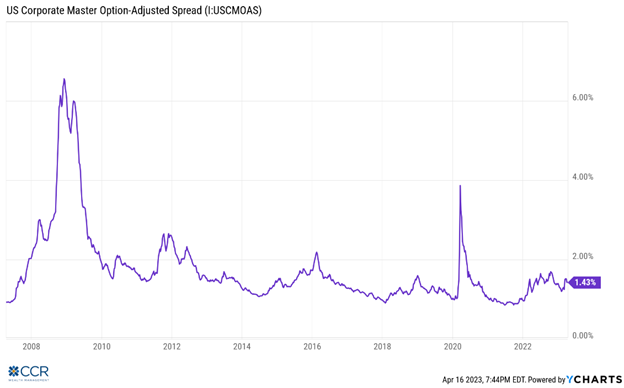
The nearby chart is the OAS of the broad US credit market. OAS stands for Option-Adjusted Spread and is just a fancy term to describe the premiums investors are getting for taking on any credit risk at all above and beyond that they can get from a government-backed bond like a Treasury or mortgage-backed security. At 1.43%, this spread is low today, and remains under the 1.52% long-term average. Put another way, investors are not being compensated much for taking on credit risk. Looking at the nearby chart, you can see the effects of economic stress on credit spreads. The spikes in 2020, and particularly 2008-2009, show the effect of economic stress, and should be read as a significant reduction in the value of credit bonds (corporate bonds, not backed by either the moral or legal obligations of the United States).
The chart above references credit spreads of only high-grade corporate bonds (rated BBB or better). Bonds with lower ratings ("junk bonds", in the parlance of yesteryear) tend to have higher spikes, commensurate with even more price volatility of the underlying bonds. For example, while the graph above depicts credit spreads widening to 3.33% in March 2020 for high-grade credit, high yield credit spiked to 7.43% over this same period. In essence-you're taking on equity-like risk to be compensated for slightly higher yields.
Our narrative includes a high probability that credit spreads will widen as this year progresses, with lower credit qualities being the most affected. Bankruptcies and defaults among stressed balance sheets factor into this view. In short, we avoid funds with names like "floating rate", "senior loans", "high yield", "high income", "subordinate" and "multi-asset income" without a thorough scouring of the underlying credit structures.
TYING IT TOGETHER: OPPORTUNITY
We have laid out a vision in these pages of what we think lies ahead in the markets in more detail than we usually do. What could go wrong?

Just about everything! To our new clients: it is important to understand that CCR Wealth Management does not employ our model portfolios to "place bets" on expected market or economic outcomes.
In the past we have discussed the notion of "probabilities", Bayes Formula, and the declining odds of complex scenarios coming to fruition because of their complexity. Think about a billiards table: accurately hitting the right angle on one globe such that it collides at a precise angle (and speed) with another globe sending it into a pocket is hard enough. Now, how about a bank shot? Try a three-ball combination shot. Our point is that statements and thought processes that follow the pattern "If A happens then B will occur, and if B, then C is the logical outcome. And since C, then I can count on D". This is hubris, and there should be multiple back-up plans.
But here goes: The large drop in headline inflation from last summer has fueled the hardest-hit areas of the stock market in the assumption that interest rate hikes are no longer needed. Moreover, to the extent that these rate hikes are slowing the economy, the Fed is most likely to cut rates this year. Why? Because that's what the Fed has done any time there has been economic or market uncertainty over most of the last 14 years. We disagree. We think equities will remain range-bound for much if not most of this year. Underlying "churn" between various sectors and styles, as happened last year, will continue. The net-effect is a "saw-tooth pattern" in the broader averages, despite underlying volatility. In-all, the market's return this year will be a big improvement over 2022, but returns will be muted. Pursuit of better "risk-adjusted return" should include a healthy dose of defensive equity exposure. We think the probability of the Fed cutting rates later this year is low (but not zero). We also think the Fed is not yet finished hiking. An economic slow-down, depending on the severity, could prompt some rate cuts next year-which will of course benefit equity investors. But ultimately, the Fed will keep rates higher for longer in the years ahead to ensure the beast is slain. Our biggest challenge, as investors, will be to keep our expectations in check. This is a buy-on-the-dip market, and we look forward to next year, and the higher probability of modest rate cuts.
Fixed income has shown a superior risk-adjusted return over the last 6 months, and we think this continues, but with the caveat that we maintain a conservative credit profile in our bonds. However, our expectation of widening credit spreads in the months ahead should be looked at as opportunity. Economic stress presents the best time to diversify into credit-and for now, we envision a scenario where this happens in the second half of the year when the influence of last year's rate hikes are more apparent.
As we mentioned at the top, our narrative is written in pencil!
If you have questions or would like to discuss your portfolio in the context of our Outlook, please do not hesitate to contact your CCR Wealth Management advisor. Enjoy the Spring!
Follow us on social media for more timely content delivered directly to your news feed!
